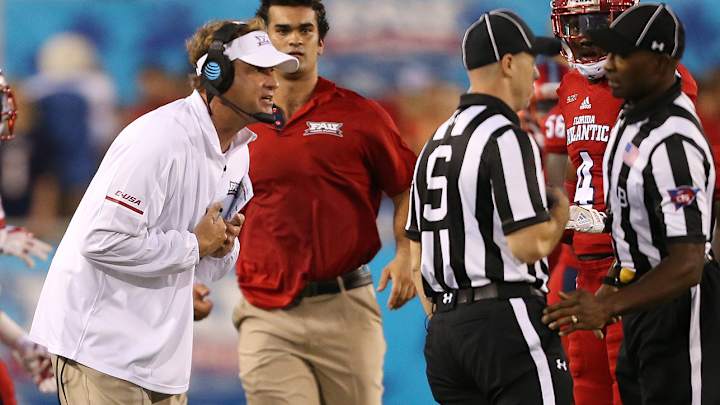Previewing the Biggest Storylines of the 2018 College Football Offseason

Alabama won, again—which might lead you to believe there’s not much new to discuss coming out of the 2017 college football season. Think again. After a wild week of playoff games and a month of bowls that saw the Big Ten look invincible and the Pac-12 deplorable, it’s time to look ahead to next fall and the trends that will shape the 2018 season. No matter how far away it might seem, September will be here in no time.
The eight-team playoff
This topic is just going to keep stewing until it becomes a reality, which means you better not be bored of it yet. The 2017 season provided an interesting case for the College Football Playoff committee. In years past, the committee’s final rankings were mildly controversial but ultimately understandable. That wasn’t so much the case in December, when three squads were shoo-ins and the fourth spot was completely up for grabs. Alabama had a case (a very, very good one, as it turns out), as did Ohio State, as did USC, as did UCF (although it was largely ignored until after the fact).
With the eventual No. 4 seed Crimson Tide winning it all for the second time—and beating the No. 3 seed Georgia, to boot—there’s a case to be made that these rankings set the cut line for college football’s elite tier too early, and that perhaps those teams left hanging deserve a chance to compete with the best for the title. This year’s postseason, in its aftermath, will only add to the argument for the eight-team field, but after just four seasons of a playoff format that was years in the making, change won’t come too swiftly.
The Group of Five
One benefit of the aforementioned playoff tweak would be the Group of Five’s increased chances of landing a representative in that expanded field. Teams like UCF deserve a shot at teams like Alabama with real stakes, and an expanded field seems like the only way that’s going to happen. Expect the same debate next season if the Knights don’t miss a beat under new coach Josh Heupel (which seems unlikely if only due to the rarity with which undefeated seasons come about), or if Memphis keeps rolling like it did in 2017. The Tigers are an especially interesting case as a Group of Five team that has remained a conference contender even after its head coach left for a Power 5 job. The American Athletic Conference isn’t just a poaching ground for great coaches; it might also be a breeding ground for teams that can sustain success that could warrant more consideration from the playoff committee.
Non-conference bunnies
This is another outgrowth of the unceasing playoff debate. One knock on Alabama this year was its 56–0 drubbing of Mercer during the mid-November weekend in which most SEC programs host FCS teams in place of the ninth conference game Big Ten, Big 12 and Pac-12 teams must survive. Scheduling these bunnies late in the year has become a pattern for the Tide, which beat Chattanooga 31–3 in 2016 and faces the Citadel on Nov. 17, 2018, but until this season, those automatic wins were a mere footnote in Alabama’s pursuit of a playoff spot, but the subsequent loss to Auburn and absence from the SEC championship game turned the Mercer game into a soft spot on the résumé.
Just because the Tide won it all doesn’t render the Mercer debate null—or it shouldn’t. Nonconference games are scheduled years out, and after all of 2017’s talk, teams may need to take a closer look at whether the FCS opponents on their schedule do more harm than good.
Lane Kiffin
Kiffin made headlines during the national championship game by taking to Twitter to critique his former employer Alabama’s stagnant offense in the first half of the national title game, closing out a debut season as Florida Atlantic head coach in which his unfiltered social media antics have been a constant source of intrigue and entertainment. The on-field results have been pretty entertaining, too; the Owls went 11–3 and throttled Akron in the Boca Raton Bowl.
College football’s most controversial coach isn’t going away any time soon. All it took was one year coaching in Conference USA for Kiffin’s name to start popping up for bigger jobs, and the fact that he was even on the periphery of the conversation around the Tennessee coaching search after spurning Vols fans for USC less than a decade ago is astounding. But Kiffinmania is real, and if the coach keeps it up at FAU, he’s going to be a more legitimate candidate for other Power 5 jobs, and soon.
Assistant coach salaries
They just keep going up, and up, and up. Granted, pay does tend to correlate with the success of these coaches’ units, but not always. Dave Aranda coordinated a top-20 defense for an LSU team that was out of contention for a national title by midseason, but the Tigers upped his salary from around $1.8 million in 2017 to $2.5 million per year for the next four seasons. That said, Aranda would have his pick of jobs if LSU hadn’t anted up. A separate SEC case to consider is Alabama offensive coordinator Brian Daboll, who earned $1.2 million in his first year at the college football level since he was a graduate assistant at Michigan State in 1999. Daboll’s offense helped Alabama win a title, adjusting on the fly as his backup quarterback stepped in late to save the day.
With so much falling on coordinators’ heads, programs are willing to pay for the high standards set, which means the way the pot is split up is changing, even as it gets larger and larger.
A new wave of star quarterbacks
Baker Mayfield is gone. So are Mason Rudolph, Lamar Jackson, Josh Rosen and Sam Darnold. The class of quarterbacks entering the 2018 NFL draft includes some of the most talked-about guys in recent college football history, and their departures mark a changing of the guard among many of the top teams. (Consider, too, that Jalen Hurts might have lost his job for good at Alabama on Monday night.) A new class of signal callers is ready to take the stage, headlined by Jake Fromm at Georgia, out to build off a runner-up finish as a true freshman; Trace McSorley at Penn State, now carrying more of the offense on his shoulders without Saquon Barkley; Kyler Murray, the Texas A&M transfer poised to take over at Oklahoma; and Tua Tagovailoa, who saved Alabama’s national title hopes after being dropped into the biggest game of the year down 13 at halftime. At many other programs among 2017’s top 10, quarterback battles rage, and they’ll dominate the conversation before—and into—next season.
The conference hierarchy
Too much importance is assigned to conference bowl records. Take the SEC, which only won two bowl games before the start of the playoff, then sent two teams to Atlanta. Meanwhile, the Big Ten went 7–1 in its bowls after being shut out of the playoff. As you can see, using bowls as a bellwether can be a bit muddled, but all things considered, both of those conferences came out of bowl season with some momentum. That wasn’t the case for the Pac-12, whose 1–7 mark left a ton to be desired no matter which way you spin it. The conference didn’t have a playoff team, and it lost several games it should have won. Headlined by a playoff team with a Heisman winner, the Big 12’s year was an impressive response to multiple years of debate over whether the league was in dire straits. Now that narrative may slowly be shifting west.
